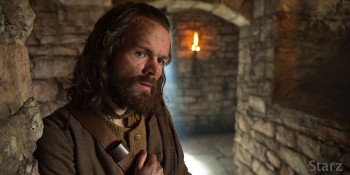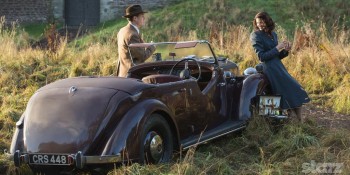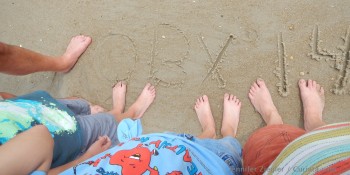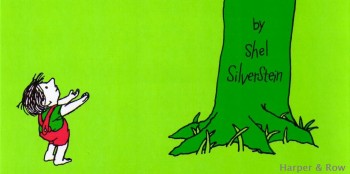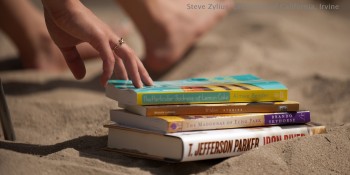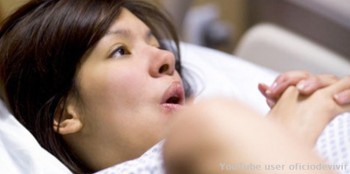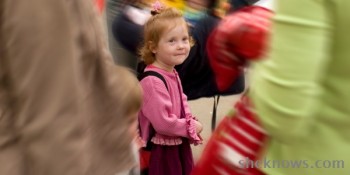Last week, the Starz adaptation of Outlander made some creative choices that separated it from the books upon which it is based — and I, for one, became concerned. In the series’ third episode, “The Way Out,” additional small changes were evident, but they served as effective tools to help with the transition from the written word to the small screen.
The episode opens with a flashback in which Claire Beauchamp, who has traveled through time to 18th-century Scotland, is back in her own world, bidding farewell to her husband Frank as she embarks on a train to the front lines to serve as a combat nurse in World War II. This scene emphasizes that Claire’s independent nature, illustrated so far during her time in and around the ancient Castle Leoch, is a characteristic of her 20th-century self as well: she is unwilling to play the role of the stereotypical housewife. Frank asks her to reconsider joining the war effort, but Claire insists on being of service. With resignation, Frank laments, “Woe betide the man who stands between you and what you set your mind upon…”
Claire finds herself in her room at Castle Leoch. Mrs. Fitz is fussing over Claire when Claire turns to tell her that she has fallen through time at Craigh na Dun, the circle of stones near Inverness. Mrs. Fitz clearly is afraid when Claire says that she is from the future and that her husband, who everyone thinks is dead, actually hasn’t been born yet. Claire reveals she is from 1945 and has unwittingly found herself in 1743. Claire isn’t sure if she can even go back to her own time. Claire pleads for Mrs. Fitz to help her get back to the stones. Mrs. Fitz slaps her in the face and accuses her of witchcraft. At this point, I am seething, as nothing remotely similar to this scenario takes place in the book.
Seconds later, however, I am relieved to find that this scene was imagined by Claire. As far as this interaction strays from the book, it does serve an important purpose here. The Highland people of the 18th century were (and, to some degree, still are) a superstitious bunch. Their folklore is filled with fairies, spirits, witchcraft, and the constant need to defend oneself against Satan’s ever-present seduction. This background may not be clear to someone not already familiar with Scottish history or anyone who has yet to read the novel. The beliefs of the locals are pivotal to the storyline, and this daydream helps to establish the backdrop for future events.
Mrs. Fitz reveals that The Gathering is coming. The Gathering is an event at which all of the men living on the land of Clan MacKenzie come and swear allegiance to their laird. Claire feels this might be an opportunity to get the Clan’s leader, Colum, to trust her — by “physicking” the ill and earning her freedom. She sets about organizing the medical suite unknowingly left to her by the late Davey Beaton, the castle’s previous healer. Her healing skills are becoming a respected and much-sought asset.
It is revealed to Claire that one of the maids’ sons has died. Claire is told that the child, young Lindsey MacNeill, succumbed the previous night. When Claire inquires as to why she wasn’t called upon, Mrs. Fitz tells her that the boy died of nothing mere mortals could cure. The boy, she says, has died because he visited “The Black Kirk,” the ruins of an old Benedictine monastery. She, as well as everyone else in the area, believes he was taken by evil spirits who dwell in the stony rubble.
Claire, of course, believes none of this but says nothing. She is then called to Colum’s rooms, where he is found having a hilarious conversation with a tailor about the length of his coat. Colum is offended that the tailor is attempting to measure Colum for a frock coat considerably longer than the standard knee-length. The tailor assumed that Colum wanted his deformed legs covered, but clearly Colum does not.
Colum requests from the new healer a massage for his pain, as Beaton used to do. He and Claire get into a conversation about the cause of Lindsey’s death; Claire is vague about her belief that Lindsey was killed by demons. Colum says, “What, you don’t have demons in Oxfordshire, Mistress?” Claire pauses and returns with, “Well, we do … but we call them Scots.” Colum appreciates her humor and invites her as his personal guest to hear a famous Welsh bard, Gwyllyn, perform in The Hall that night.
At The Hall, Claire formally introduces herself to Mrs. Fitz’s granddaughter, Laoghaire MacKenzie. The girl obviously admires Jamie, the young man who saved her from punishment in the previous episode. Laoghaire admits that, while she likes Jamie, he does not return her affection. Claire promises to steer Jamie in her direction. However, her attempt is unsuccessful. Several times, Claire tries to encourage Jamie to attend to Laoghaire, but he is just shy of rude to her in order to converse directly with Claire.
Jamie and Claire discuss the talents of the bard, which are extraordinary. This musician, played by renowned medieval Gaelic singer and poet Gillebride MacMillan, is a marvel. The snippets of his performances alone make Outlander a must-see: the gorgeous vocals, rich in emotion and depth, further complement the already glorious set designs of this series.
Jamie notices that Claire has been imbibing Colum’s Rhenish wine. He asks her to attend to his bandages, although this is just an excuse to escort her safely from The Hall. Sparks fly when Claire and Jamie are alone in her surgery. The chemistry portrayed by the leads is fantastic. This is one thing that makes this adaptation successful. The almost karmic relationship between Jamie and Claire, established from the first book, is a key element in the entire Outlander series.
On a visit to the castle’s herb garden, Claire meets Geillis Duncan, who tells her that Mrs. Fitz’s nephew, Thomas Baxter, is taken with the same illness that killed the boy’s friend Lindsey. Geillis further informs Claire that the local priest, Father Bain, is going to exorcise the boy. Geillis warns Claire to stay away, for fear that she will be associated with evil spirits. Claire goes anyway, much to the consternation of her guard, and encounters the strident, almost psychotic, Catholic priest. He undertakes an exorcism, while Claire, realizing the boy has been poisoned by an unknown source, stands by helplessly.
A parallel storyline emerges here, with Claire recognizing her attraction to Jamie and witnessing Jamie and Laoghaire kissing quite passionately in an alcove. Claire teases Jamie about it at dinner, but one of the men warns Claire that if Colum or Laoghaire’s father hears of it, Jamie could get more than a beating — he could get a wife, “And that’s not the wife he should have …”
A happy turn of events has Claire being escorted to Cranesmuir, a village near the castle, to visit Geillis, the procurator fiscal’s wife. The Clan’s military leader, Dougal, suggests that Claire might stock her medical shelves in preparation for The Gathering. Claire is quite shocked to see that, as attractive and charming as Geillis is, her husband, the Fiscal, is much older, quite unattractive, and in ill health.
When a boy in the town confesses to stealing a loaf of bread, Geillis tells Claire that the boy will lose his hand. Claire is horrified and asks if the sentence is necessary. Her new friend asks probing questions, such as, “Do they not have that in Oxfordshire, then?” However, to appease her friend, Geillis, in a quite bewitching fashion, convinces her husband, whose job it is to settle disputes and determine punishments, to be lenient. The boy gets an hour in the pillory with one ear nailed. Claire again cannot believe that this is considered leniency, and Geillis continues her questions, making Claire worry that Geillis somehow knows that Claire is from a different time.
Claire is able to avoid further explanation when Jamie comes to escort her back to the castle. Before they go, Claire asks if Jamie can do something to help the boy, whose ear has been nailed to the pillory all day. He agrees, and Claire creates a diversion while Jamie pulls the nail, which saves the boy from having to tear himself loose.
Reminded of the plight of the violently ill Thomas Baxter, Claire asks Jamie if he can take her to The Black Kirk. Here, she discovers that a plant that everyone takes for wood garlic is, in fact, a very similar-looking — and deadly poisonous — lily-of-the-valley. This plant is commonly eaten by boys who visit the Kirk as a sign of their bravery. Claire knows the cure and, despite the angry and threatening protestations of Father Bain, gives the boy an anecdote. Soon after, the boy is cured. Instead of being delighted, Father Bain is humiliated and threatens Claire that “God will have the last word. I promise you that.”
The episode ends with another performance by Gwyllyn the Bard. This time, Claire is treated — by Jamie — to a translation of the Welsh lyrics. The song, it turns out, is about a woman who touched a stone at a fairy ring near the celebration of Samhain and was transported to another time. She made a life for herself in that other time, finding friends and lovers. But she longed for her home and the man she had left behind, and at another time near Samhain, she returned to the stone circle, touched the stone, and was transported once again to her own time. This story echoes Claire’s own journey through the stones, which also took place at a stone circle near the time of Samhain. She decides a return to 1945 — and her dear Frank — is possible, and she determines to find a way back.
No gratuitous nudity distracted from the storyline in this episode. While it varied a bit from the novel — for instance, the poisoning of the boys at The Black Kirk didn’t happen in the book — the changes were necessary to translate the plot to screen and to provide a platform for the story’s progression.
